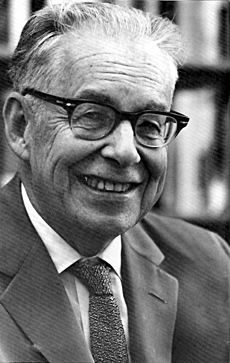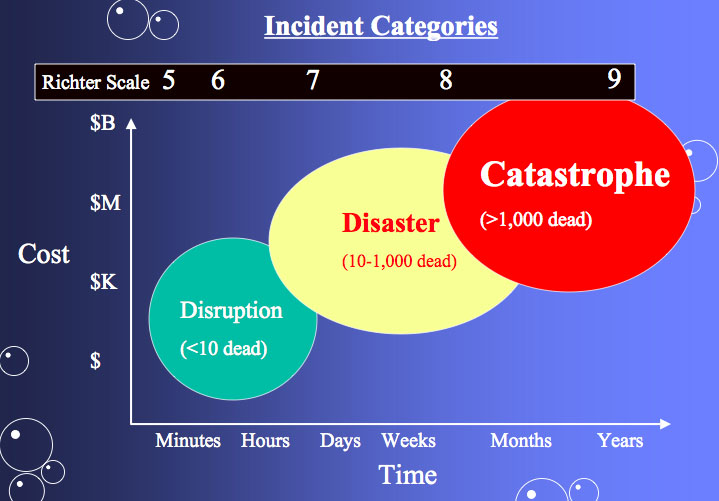Richter scale facts for kids

The Richter magnitude scale is a scale of numbers used to tell the size of earthquakes. Charles Richter developed the Richter Scale in 1935. His scale was based on the seismogram measured by a particular type of seismometer at a distance of 100 kilometres (62 mi) from the earthquake.
Earthquakes 4.5 or higher on the Richter scale can be measured by tools all over the world.
The scale is logarithmic, with a base of 10. The amplitude of an earthquake that scores 3.0 is about 10 times the amplitude of one that scores 2.0. The energy that is released increases by a factor of about 32.
| Descriptor | Richter Magnitude number | Damage caused by the earthquake | Frequency of occurrence |
|---|---|---|---|
| Micro | Less than 2.0 | Micro (very small) earthquakes, people cannot feel these. | About 8,000 each day |
| Very minor | 2.0-2.9 | People do not feel these, but seismographs are able to detect them. | About 1,000 per day |
| Minor | 3.0-3.9 | People often feel these, but they almost never cause damage. | About 49,000 each year |
| Light | 4.0-4.9 |
Objects inside houses are disturbed, causing noise. Things are rarely damaged.. |
About 6,200 each year |
| Moderate | 5.0-5.9 |
Buildings that are not built well may be damaged. Light objects inside a house may be moved. |
About 800 per year |
| Strong | 6.0-6.9 |
Moderately powerful. May cause a lot of damage in a larger area. |
About 120 per year |
| Major | 7.0-7.9 | Can damage things seriously over larger areas. | About 18 per year |
| Great | 8.0-9.9 | Massive damage is caused. Heavy objects are thrown into the air and cracks appear on the ground, as well as visible shockwaves. Overhead highways may be destroyed, and buildings are toppled. | About 1 per 20 years |
| Meteoric | 10.0+ | There are no records of anything of this size. The vibration is about the same as that of a 15 mi meteor. | Unknown |
(Adapted from U.S. Geological Survey documents)
The earthquake with the biggest recorded magnitude was the Great Chilean Earthquake. It had a magnitude of 9.5 (approximately 9.5 on the Richter scale) and occurred in 1960. About 6,000 people died because of the earthquake.
More examples
| Approximate Richter Magnitude number | Seismic energy equivalent: Amount of TNT | Example event |
|---|---|---|
| 0.5 | 5.6kg | Large hand grenade |
| 1.5 | 178kg | Bomb used in WWII |
| 2 | 1 metric ton | Large Bomb used in WWII |
| 2.5 | 5.6 metric tons | Blockbuster bomb (dropped from airplanes) in WWII |
| 3.5 | 178 metric tons | Chernobyl accident, 1986 |
| 4 | 1 kiloton | Small atomic bomb |
| 5 | 32 kilotons | Nagasaki atomic bomb Lincolnshire earthquake (UK), 2008 |
| 5.4 | 150 kilotons | 2008 Chino Hills earthquake (Los Angeles, United States) |
| 5.5 | 178 kilotons | Little Skull Mtn. earthquake (NV, USA), 1992 Alum Rock earthquake (CA, USA), 2007 |
| 6.0 | 1 megaton | Double Spring Flat earthquake (NV, USA), 1994 |
| 6.5 | 5.6 megatons | Caracas (Venezuela), 1967 Rhodes (Greece), 2008 Eureka Earthquake (Humboldt County CA, USA), 2010 |
| 6.7 | 16.2 megatons | Northridge earthquake (CA, USA), 1994 |
| 6.9 | 26.8 megatons | San Francisco Bay Area earthquake (CA, USA), 1989 |
| 7.0 | 32 megatons | Java earthquake (Indonesia), 2009, 2010 Haiti Earthquake |
| 7.1 | 50 megatons | Energy released is equivalent to that of Tsar Bomba, the largest thermonuclear weapon ever tested 1944 San Juan earthquake |
| 7.5 | 178 megatons | Kashmir earthquake (Pakistan), 2005 Antofagasta earthquake (Chile), 2007 |
| 7.8 | 600 megatons | Tangshan earthquake (China), 1976
North Canterbury (New Zealand) 2016 |
| 8.0 | 1 gigaton | San Francisco earthquake (CA, USA), 1906 Queen Charlotte earthquake (BC, Canada), 1949 México City earthquake (Mexico), 1985 Gujarat earthquake (India), 2001 Chincha Alta earthquake (Peru), 2007 Sichuan earthquake (China), 2008 (initial estimate: 7.8) 1894 San Juan earthquake |
| 8.5 | 5.6 gigatons | Toba eruption 75,000 years ago; the largest known volcanic event. Sumatra earthquake (Indonesia), 2007 |
| 9.0 | 32 gigatons | 2011 Sendai, Japan Earthquake and Tsunami, Lisbon Earthquake (Lisbon, Portugal), All Saints Day, 1755 |
| 9.1 | 67 gigatons | Indian Ocean earthquake, 2004 (40 ZJ in this case) |
| 9.2 | 90.7 gigatons | Anchorage earthquake (AK, USA), 1964 |
| 9.5 | 178 gigatons | Valdivia earthquake (Chile), 1960 |
| 13.0 | 108 megatons = 100 teratons | Yucatán Peninsula impact (causing Chicxulub crater) 65 Ma ago. |
Other pages
See also
 In Spanish: Escala sismológica de Richter para niños
In Spanish: Escala sismológica de Richter para niños


